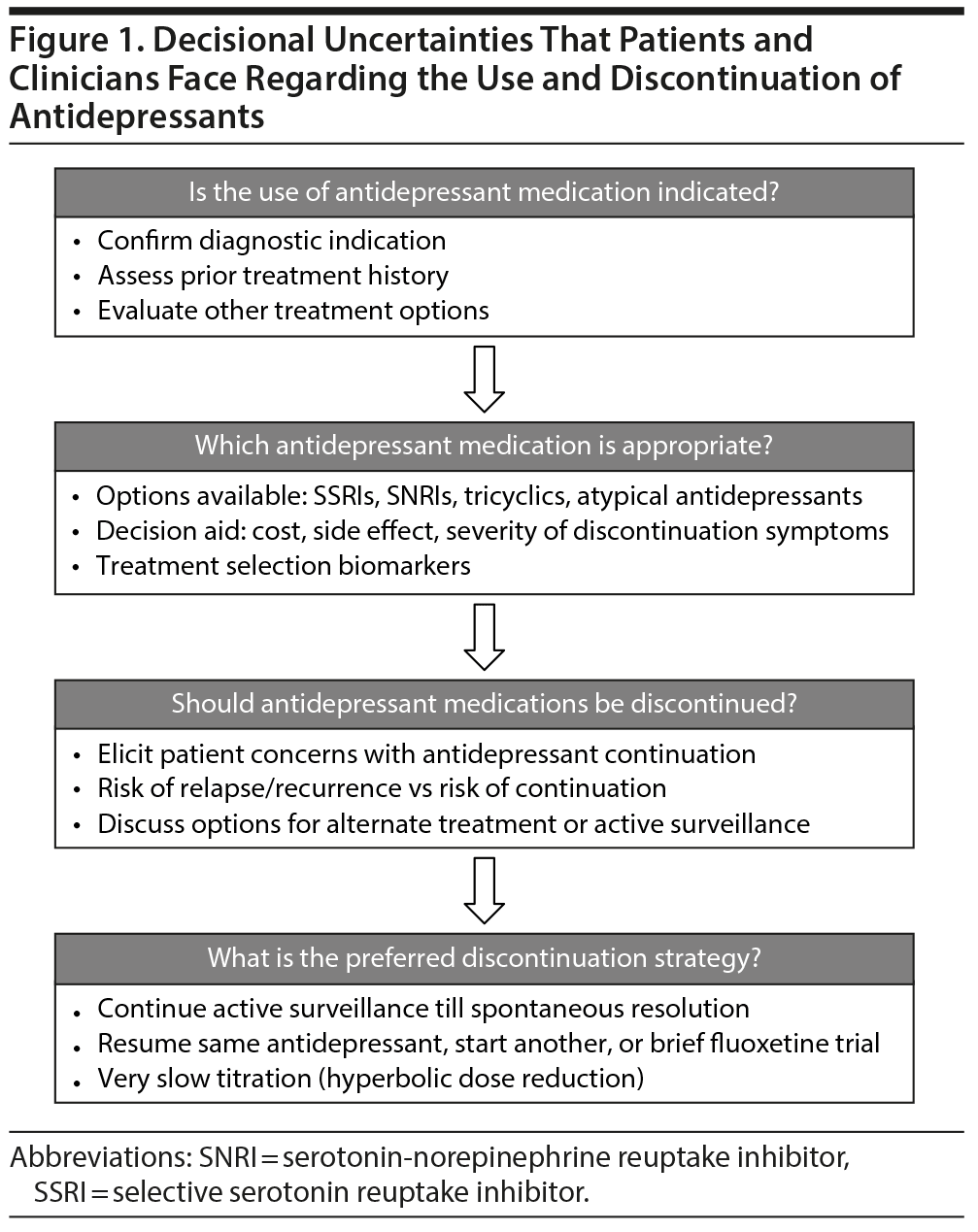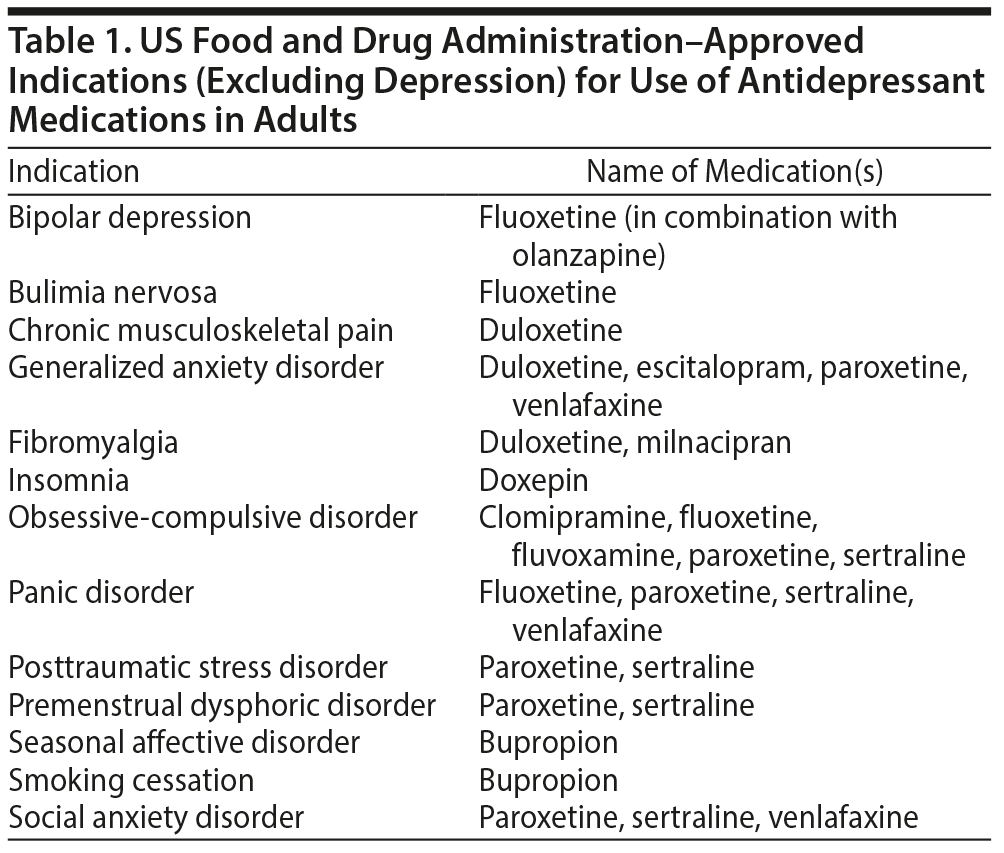Recent media reports have refocused attention on the syndromic manifestation experienced by some patients as they discontinue their antidepressant medication (“discontinuation syndrome”). This attention has been accompanied by criticisms that mainstream psychiatry has either ignored or minimized these symptoms and exposed patients to potentially harmful and addictive treatments. Yet, there has been very limited original research on the prevalence of discontinuation syndrome in the last decade. There is growing concern that labeling antidepressants as addictive may drive down the use of these medications and exacerbate the mental health crisis in which depression is often undiagnosed and undertreated. Hence, the onus of guiding patients through questions and concerns related to the use and discontinuation of antidepressants has fallen mainly on primary care and psychiatric clinicians. This report discusses some common decisional uncertainties relevant to antidepressant discontinuation and recommends a shared decision-making approach. Further, this report seeks to outline a roadmap for clinicians to drive research on this important yet understudied topic.
Discontinuing Antidepressants:
How Can Clinicians Guide Patients and Drive Research?
ABSTRACT
Recent media reports have refocused attention on the syndromic manifestation experienced by some patients as they discontinue their antidepressant medication (“discontinuation syndrome”). This attention has been accompanied by criticisms that mainstream psychiatry has either ignored or minimized these symptoms and exposed patients to potentially harmful and addictive treatments. Yet, there has been very limited original research on the prevalence of discontinuation syndrome in the last decade. There is growing concern that labeling antidepressants as addictive may drive down the use of these medications and exacerbate the mental health crisis in which depression is often undiagnosed and undertreated. Hence, the onus of guiding patients through questions and concerns related to the use and discontinuation of antidepressants has fallen mainly on primary care and psychiatric clinicians. This report discusses some common decisional uncertainties relevant to antidepressant discontinuation and recommends a shared decision-making approach. Further, this report seeks to outline a roadmap for clinicians to drive research on this important yet understudied topic.
J Clin Psychiatry 2019;80(6):19com13047
To cite: Jha MK. Discontinuing antidepressants: how can clinicians guide patients and drive research? J Clin Psychiatry. 2019;80(6):19com13047.
To share: https://doi.org/10.4088/JCP.19com13047
© Copyright 2019 Physicians Postgraduate Press, Inc.
aDepartments of Psychiatry and Neuroscience, Icahn School of Medicine at Mount Sinai, New York, New York
bCenter for Depression Research and Clinical Care, UT Southwestern Medical Center, Dallas, Texas
*Corresponding author: Manish K. Jha, MBBS, Departments of Psychiatry and Neuroscience, Icahn School of Medicine at Mount Sinai, 1 Gustave L. Levy Pl, Box 1230, New York, NY 10029 ([email protected]).
The occurrence of symptoms following discontinuation of antidepressants (such as selective serotonin reuptake inhibitors [SSRIs) and serotonin-norepinephrine reuptake inhibitors (SNRIs]) is well known.1,2 In fact, the US Food and Drug Administration (FDA) labels for these agents caution about “dysphoric mood, irritability, agitation, dizziness, sensory disturbances (eg, paresthesias such as electric shock sensations and tinnitus), anxiety, confusion, headache, lethargy, emotional lability, insomnia, and hypomania” following discontinuation.3 Yet, recent media reports have fueled “anxiety about antidepressants.”4 In a recent report, Pies5 eloquently discusses the 2 competing narratives (“discontinuation syndrome” vs “withdrawal syndrome”) and suggests that many clinicians underestimate the frequency and severity of symptoms associated with antidepressant discontinuation. To avoid consideration of antidepressants as addictive drugs,1,5 this report chooses to use the term discontinuation syndrome over withdrawal.
This discourse about antidepressants, one of the most commonly used medication types,6 may affect public health, as evidenced by the postponement of upcoming UK National Institute on Health and Clinical Excellence (NICE) guidelines due to concerns about antidepressant “withdrawal.”7 This is troublesome, as rates of adequate treatment of major depressive disorder (MDD) in the community remain low.8 Despite recommendations for universal screening,9,10 fewer than 3% of patients in ambulatory care settings receive screening for depression.11 While primary care has emerged as an important hub for management of depression,12 making it the first point of care where antidepressants are initiated,11,13 about half of patients initiated on pharmacotherapy for depression in primary care do not return for a follow-up visit.13 Thus, clinicians need to inform patients about the risk of discontinuation symptoms before initiating antidepressants, while doing it in a fashion that engages them in care, promotes adherence, and does not dissuade them from seeking this effective treatment. As discussed below in detail, implementation of a shared decision-making (SDM) approach may assist in this task. In addition, this report briefly discusses selected recent publications in the psychiatric literature on the topic of antidepressant discontinuation and highlights some key decisional uncertainties that clinicians and patients often face. It then recommends a measurement-based care (MBC) practice to collect more information at the individual patient level and to guide patients in devising a personalized approach to managing discontinuation of antidepressants. Finally, this report seeks to outline a roadmap for clinicians to drive research on this important yet understudied topic.
A Brief Discussion of Selected Recent Publications
In recent years, Fava and colleagues have published 2 systematic reviews on discontinuation of SSRIs14 and SNRIs,15 with the highest rates of symptoms reported with paroxetine and venlafaxine, respectively. However, tools used to assess discontinuation symptoms have not been uniform.16 Even when the same rating scale is used, studies differ in the threshold they used to define the presence of discontinuation symptoms.16 These issues have added to the uncertainty regarding the true prevalence of burdensome symptoms after antidepressant discontinuation. High prevalence estimates (over 50%) of discontinuation syndrome were reported in a recent systematic review that included results from a direct-to-consumer survey on prevalence of these symptoms among longtime users of antidepressants.17 Critiqued in detail by Jauhar and Hayes,16 this report has generated significant media attention and was used in a call by several experts to delay the NICE practice guidelines on depression.18 Recent reports have also explored the management of discontinuation syndrome with antidepressant medications, discussed in detail later.19,20
Shared Decision-Making Approach
Using the SDM approach, clinician(s) and patients (along with other health professional(s), friends, and family) make an optimal treatment decision when an unequivocally superior option does not exist.21 This process is bidirectional: the clinician shares information about available options, including the risks and benefits, while the patient conveys his or her specific preferences or values.21 In clinical practice, SDM can be implemented by a simple 3-step model that offers choices, discusses options, and moves patients toward making a decision.22 Decision aids are important tools of SDM as they facilitate sharing of knowledge and can be used outside of a clinic visit. A decision aid tool developed specifically for antidepressants was shown to improve the comfort of making decisions in both patients and clinicians.23 Relevant to the SDM approach for antidepressant discontinuation, this report frames decisional uncertainties as clinical questions regarding the need for, the choice among, and the necessity of continuing antidepressants, as well as potential options for managing discontinuation syndrome (Figure 1).


Decisional Uncertainties
Is the use of antidepressant medication indicated? In addition to depression or MDD, antidepressants are approved by the FDA for several indications (see Table 1). A thorough diagnostic evaluation should establish the presence of one of more of these conditions before antidepressants are offered as a treatment option. However, antidepressants are not the sole effective option available for these conditions. Even for MDD, alternative options include psychotherapy, exercise, neurostimulation, and nonantidepressant pharmacotherapy.24,25 Psychotherapy is recommended as first line treatment for mild-to-moderate severity MDD.24 Antidepressants (with or without psychotherapy) are usually recommended as first line treatment for MDD patients with severe depression.24 To inform the treatment options offered to the patient, clinicians should systematically assess prior treatment history. After inadequate improvement with 2 or more antidepressant medication courses (treatment-resistant depression [TRD]), likelihood of remission with the next medication trial is below 15%.26 Thus, presence of TRD should inform patients and clinicians to select TRD-specific pharmacologic (such as intranasal esketamine) or neuromodulation (such as repetitive transcranial magnetic stimulation and electroconvulsive therapy) treatments.25,27 Before making a treatment decision, clinicians should check with patients about their knowledge and comfort with making treatment decision. In addition to their preference for a specific treatment, clinicians should also explore barriers to treatment. Such barriers may include cost, time commitment, access to trained providers, and stigma related to mental illness. With a third of the US population living in an area with a shortage of mental health professionals,28 access to evidence-based psychotherapy may be limited.


Which antidepressant medication is appropriate? The choice of antidepressant medications (SSRIs, SNRIs, tricyclics, and atypical antidepressants) as an initial option may seem daunting to patients. Practice guidelines recommend use of subjective factors such as anticipated side effect profile and patient preference.29 In addition, clinicians should inquire about any previous history of discontinuation syndrome, as it may guide toward selection of antidepressants with a lower likelihood of these symptoms (such as fluoxetine) as compared to those with a higher likelihood (such as paroxetine and venlafaxine). A decision aid developed by Mayo Clinic and available online30 can be used to provide patients with information about cost and side effects of commonly used antidepressants as well as likelihood of discontinuation syndrome. As obesity31,32 and systemic inflammation33–35 have been associated with poor response to SSRIs (escitalopram and sertraline) in post hoc analyses from 3 separate clinical trials, their validation as treatment selection biomarkers in future clinical trials may inform antidepressant options presented to patients and potentially obviate the need for multiple trials of antidepressants and decrease the risk of discontinuation symptoms.36,37
Should antidepressant medications be discontinued? Common scenarios leading to this question include lack of improvement, intolerable side effects of ongoing treatment, relapse/recurrence of symptoms after initial treatment while taking the antidepressant, comorbid medical illnesses or a concomitant medication use that changes the risk vs benefit profile, planning for pregnancy or breast-feeding, and a period of sustained improvement or recovery during which the use of an antidepressant may no longer seem necessary.19 Clinicians should elicit concerns from patients about antidepressant continuation to check if one or more of the above scenarios apply and personalize the discussion of options accordingly. Further, a collaborative approach including consultations with other medical and behavioral health providers may be necessary especially in case of comorbid medical illnesses or when planning for pregnancy/breastfeeding. Clinicians may also consider recent reports demonstrating the benefits of continuing antidepressants either alone or with evidence-based therapy in reducing the likelihood of relapse/recurrence.38,39 Data visualization tools in electronic health records that graphically present an individual patient’s changes in self-reports of symptom severity, quality of life, etc, as a function of changes in antidepressant treatment12 may be used to inform decision about antidepressant discontinuation.
What is the preferred discontinuation strategy? The FDA prescribing label recommends gradual reduction in dose instead of abrupt discontinuation.3 As noted by Fava et al,14 gradual taper has not been shown to help in reducing the frequency of discontinuation syndrome. However, gradual taper has been shown to reduce the likelihood of symptomatic relapse over the next year after discontinuation.40 This discrepancy might be attributed to the short periods of taper used in previous studies. Thus, Horowitz and Taylor20 recently proposed hyperbolic dose reduction, which was extended by Ruhe et al41 as a multistep dose reduction paradigm in which the initial step is to reduce the dose to half of the minimally effective dose in 1 week and then reduce very gradually and decide the time spent at each dose by SDM between clinician and the patient. If symptoms are tolerable and not burdensome, active surveillance using the MBC approach until spontaneous resolution may be an option. If the symptoms are intolerable, management strategies may include resumption of previously tolerated dose, switch to adequate dose of another SSRI/SNRI, cross-tapering—reducing the dose of current medication gradually while increasing the dose of another—or using a brief trial of fluoxetine to bridge from an SSRI/SNRI to a nonserotonergic antidepressant like bupropion.19 Clinicians should elicit the patient’s views about discontinuation and iteratively find the optimal strategy for individual patients.
Active Surveillance With
Measurement-Based Care Approach
Finally, as mood and anxiety symptoms may occur as part of discontinuation syndrome, they need to be differentiated from those either present at baseline42,43 or worsened with treatment.44 Thus, systematic assessment of these symptoms using the MBC approach,45 prior to and during antidepressant treatment, can help in prospective assessment of their onset or worsening after antidepressant discontinuation. Using the MBC approach, regular follow-up visits should be conducted to detect symptom changes promptly prior to their worsening to intolerable levels. The side effect monitoring scale of MBC46 may also be adapted to monitor the frequency, intensity, and burden of discontinuation-emergent symptoms. Finally, the monitoring during active surveillance should include thorough review of systems and additional workup to rule out any comorbid medical condition that may account for these symptoms.19
Roadmap for Clinicians Driving Research
Despite SSRIs being some of the most commonly prescribed antidepressants, there has not been a single randomized placebo-controlled study assessing prevalence of discontinuation syndrome in the past decade.16 This may reflect the lack of importance placed on studying discontinuation symptom. In the second level of Sequenced Treatment Alternatives to Relieve Depression (STAR*D) study, patients were switched directly from a serotonergic antidepressant (citalopram) to either a nonserotonergic antidepressant (bupropion) or one of the two serotonergic antidepressants (sertraline and venlafaxine).47 Lack of systematic assessment of discontinuation syndrome comparing switch to a nonserotonergic vs serotonergic antidepressant may have been a missed opportunity. However, it is noteworthy that tolerability, side effect severity, and attrition rates in STAR*D were similar between switch to bupropion vs the 2 serotonergic switch arms.47
Advances in health information technology that bring together data from multiple sources such as prescription records, progress notes, and patient-rated symptom measures12 offer a unique opportunity for clinicians to systematically collect data and drive research on discontinuation syndrome. The first step in this process will be to adopt a common tool for assessing symptoms in order to estimate the prevalence of discontinuation syndrome. Clinicians may then inform research into individual traits of patients that predispose to discontinuation syndrome. Finally, clinicians can drive research into efficacy of antidepressants over very long periods while considering the variability in course of symptoms. These issues are discussed briefly below.
Describing the syndromic manifestation and estimating its prevalence. As the range of symptoms reported following discontinuation is quite broad, clinicians may systematically collect patient reports of experiences following discontinuation of their antidepressant that include estimates of frequency, intensity, and burden of these symptoms. Further, clinicians and patients should inform definitions of clinically significant discontinuation symptoms which can then be used to estimate its prevalence. This is urgently needed due to the inconsistencies in definition of discontinuation syndrome used to date.16
Characteristics of individual patients. Clinicians may find it useful to know if there are specific individual patient characteristics that may predict discontinuation syndrome with any antidepressant (nonspecific predictor) or higher likelihood of discontinuation syndrome with one antidepressant vs another (moderator). Finally, tools of natural language processing paired with biological assays48,49 may be extended to identify cases of prolonged (lasting for years) and/or life-threatening discontinuation syndrome, or an inability to discontinue antidepressant once initiated, and the underlying biological mechanisms.
Risk vs benefit of continued antidepressant treatment. While they are often prescribed for very long periods, there is very limited information available on safety or continued benefit of antidepressants when prescribed for 3 or more years. Thus, systematic collection of information from real-world practices may reduce the decisional uncertainty for patients who improve with medication and seek options for discontinuation.
Course of illness. Clinicians may inform the discussion about antidepressant continuation by characterizing the different trajectories of symptoms and the variable course of illness. For example, it is not uncommon for patients to have a particular set of symptoms earlier in life (such as predominant anxiety disorder) that is distinct from those later in life (such as predominant depression). Thus, if SSRIs were used to treat anxiety disorder early on, subsequent emergence of a depressive illness may be misconstrued as medication-associated while it might be an evolution of underlying disorder. Another clinical example includes a patient who seeks psychiatric care for worsening depression and is started on pharmacotherapy but continues to get worse. In such cases, it will be important to distinguish whether treatment worsened the symptoms or whether the pharmacotherapy was ineffective and the symptoms would have worsened irrespective of the type of treatment initiated.
CONCLUSION
Antidepressant medications are important tools in addressing the public health crisis of inadequately treated mental illnesses. Thus, labeling antidepressants as addictive may dissuade patients from seeking this often life-saving treatment. There is an urgent need to understand the prevalence and biological underpinnings of discontinuation syndrome. Meanwhile, clinicians and patients may use a shared decision-making approach to reduce decisional uncertainties and improve treatment adherence. Finally, a systematic measurement-based care practice will help patients and clinicians in proactively managing symptoms if they occur after antidepressant discontinuation.
Published online: November 26, 2019.
Potential conflicts of interest: Dr Jha has received contract research grants from Acadia Pharmaceuticals and Janssen Research & Development.
Funding/support: This report did not receive any external funding.
REFERENCES
1. Jauhar S, Hayes J, Goodwin GM, et al. Antidepressants, withdrawal, and addiction; where are we now? J Psychopharmacol. 2019;33(6):655–659. PubMed CrossRef
2. Dilsaver SC, Greden JF. Antidepressant withdrawal phenomena. Biol Psychiatry. 1984;19(2):237–256. PubMed
3. Paroxetine [package insert]. Research Triangle, NC: GlaxoSmithKline; 2012.
4. Perlis RH. Anxiety about antidepressants. Am J Psychiatry. 2018;175(6):500–501. PubMed CrossRef
5. Pies RW. Antidepressant discontinuation: a tale of two narratives. J Clin Psychopharmacol. 2019;39(3):185–188. PubMed CrossRef
6. Rui P, Okeyode T. National Ambulatory Medical Care Survey: 2016 National Summary Tables. CDC website. https://www.cdc.gov/nchs/data/ahcd/namcs_summary/2016_namcs_web_tables.pdf. 2016.
7. Mahase E. Antidepressant withdrawal guidance must be updated to reflect evidence. BMJ. 2019;365:l2283. PubMed CrossRef
8. Kessler RC, Berglund P, Demler O, et al; National Comorbidity Survey Replication. The epidemiology of major depressive disorder: results from the National Comorbidity Survey Replication (NCS-R). JAMA. 2003;289(23):3095–3105. PubMed CrossRef
9. Siu AL, Bibbins-Domingo K, Grossman DC, et al; US Preventive Services Task Force (USPSTF). Screening for depression in adults: US Preventive Services Task Force Recommendation Statement. JAMA. 2016;315(4):380–387. PubMed CrossRef
10. Jha MK, Qamar A, Vaduganathan M, et al. Screening and management of depression in patients with cardiovascular disease: JACC state-of-the-art review. J Am Coll Cardiol. 2019;73(14):1827–1845. PubMed CrossRef
11. Samples H, Stuart EA, Saloner B, et al. The role of screening in depression diagnosis and treatment in a representative sample of US primary care visits [published online ahead of print August 6, 2019]. J Gen Intern Med. 2019. PubMed CrossRef
12. Trivedi MH, Jha MK, Kahalnik F, et al. VitalSign6: A Primary Care First (PCP-First) model for universal screening and measurement-based care for depression. Pharmaceuticals (Basel). 2019;12(2):E71. PubMed CrossRef
13. Jha MK, Grannemann BD, Trombello JM, et al. A structured approach to detecting and treating depression in primary care: VitalSign6 project. Ann Fam Med. 2019;17(4):326–335. PubMed CrossRef
14. Fava GA, Gatti A, Belaise C, et al. Withdrawal symptoms after selective serotonin reuptake inhibitor discontinuation: a systematic review. Psychother Psychosom. 2015;84(2):72–81. PubMed CrossRef
15. Fava GA, Benasi G, Lucente M, et al. Withdrawal symptoms after serotonin-noradrenaline reuptake inhibitor discontinuation: systematic review. Psychother Psychosom. 2018;87(4):195–203. PubMed CrossRef
16. Jauhar S, Hayes J. The war on antidepressants: what we can, and can’t conclude, from the systematic review of antidepressant withdrawal effects by Davies and Read. Addict Behav. 2019;97:122–125. PubMed CrossRef
17. Davies J, Read J. A systematic review into the incidence, severity and duration of antidepressant withdrawal effects: are guidelines evidence-based? Addict Behav. 2019;97:111–121. PubMed CrossRef
18. Davies J, Read J, Hengartner MP, et al. Clinical guidelines on antidepressant withdrawal urgently need updating. BMJ. 2019;365:l2238. PubMed CrossRef
19. Jha MK, Rush AJ, Trivedi MH. When discontinuing SSRI antidepressants is a challenge: management tips. Am J Psychiatry. 2018;175(12):1176–1184. PubMed CrossRef
20. Horowitz MA, Taylor D. Tapering of SSRI treatment to mitigate withdrawal symptoms. Lancet Psychiatry. 2019;6(6):538–546. PubMed CrossRef
21. Barry MJ, Edgman-Levitan S. Shared decision making—pinnacle of patient-centered care. N Engl J Med. 2012;366(9):780–781. PubMed CrossRef
22. Elwyn G, Frosch D, Thomson R, et al. Shared decision making: a model for clinical practice. J Gen Intern Med. 2012;27(10):1361–1367. PubMed CrossRef
23. LeBlanc A, Herrin J, Williams MD, et al. Shared decision making for antidepressants in primary care: a cluster randomized trial. JAMA Intern Med. 2015;175(11):1761–1770. PubMed CrossRef
24. Park LT, Zarate CA Jr. Depression in the primary care setting. N Engl J Med. 2019;380(6):559–568. PubMed CrossRef
25. Otte C, Gold SM, Penninx BW, et al. Major depressive disorder. Nat Rev Dis Primers. 2016;2(1):16065. PubMed CrossRef
26. Rush AJ, Trivedi MH, Wisniewski SR, et al. Acute and longer-term outcomes in depressed outpatients requiring one or several treatment steps: a STAR*D report. Am J Psychiatry. 2006;163(11):1905–1917. PubMed CrossRef
27. Jha MK, Trivedi MH. Experimental therapies for treatment-resistant depression: “how do you decide when to go to an unproven or experimental therapy with patients that are treatment-resistant depression?”. Focus Am Psychiatr Publ. 2018;16(3):279–284. PubMed
28. Designated Health Professional Shortage Areas Statistics: Third Quarter of Fiscal Year 2019 Designated HPSA Quarterly Summary. Health Resources & Services Administration website. https://data.hrsa.gov/Default/GenerateHPSAQuarterlyReport. 2019. Accessed August 14, 2019.
29. Gelenberg AJ, Freeman MP, Markowitz JC, et al; Work Group on Major Depressive Disorder. Practice Guideline for the Treatment of Patients With Major Depressive Disorder. 3rd ed. Arlington, VA: American Psychiatric Association; 2010.
30. Depression Medication Choice Decision Aid. Mayo Clinic website. https://depressiondecisionaid.mayoclinic.org/app/depression. Accessed August 14, 2019.
31. Jha MK, Wakhlu S, Dronamraju N, et al. Validating pre-treatment body mass index as moderator of antidepressant treatment outcomes: Findings from CO-MED trial. J Affect Disord. 2018;234:34–37. PubMed CrossRef
32. Green E, Goldstein-Piekarski AN, Schatzberg AF, et al. Personalizing antidepressant choice by sex, body mass index, and symptom profile: an iSPOT-D report. Personalized Medicine in Psychiatry. 2017;1–2:65–73. CrossRef
33. Jha MK, Minhajuddin A, Chin-Fatt C, et al. Sex differences in the association of baseline c-reactive protein (CRP) and acute-phase treatment outcomes in major depressive disorder: Findings from the EMBARC study. J Psychiatr Res. 2019;113:165–171. PubMed CrossRef
34. Jha MK, Minhajuddin A, Gadad BS, et al. Can C-reactive protein inform antidepressant medication selection in depressed outpatients? findings from the CO-MED trial. Psychoneuroendocrinology. 2017;78:105–113. PubMed CrossRef
35. Uher R, Tansey KE, Dew T, et al. An inflammatory biomarker as a differential predictor of outcome of depression treatment with escitalopram and nortriptyline. Am J Psychiatry. 2014;171(12):1278–1286. PubMed CrossRef
36. Jha MK, Trivedi MH. Personalized antidepressant selection and pathway to novel treatments: clinical utility of targeting inflammation. Int J Mol Sci. 2018;19(1):E233. PubMed CrossRef
37. Miller AH, Trivedi MH, Jha MK. Is C-reactive protein ready for prime time in the selection of antidepressant medications? Psychoneuroendocrinology. 2017;84:206. PubMed CrossRef
38. Jarrett RB, Minhajuddin A, Gershenfeld H, et al. Preventing depressive relapse and recurrence in higher-risk cognitive therapy responders: a randomized trial of continuation phase cognitive therapy, fluoxetine, or matched pill placebo. JAMA Psychiatry. 2013;70(11):1152–1160. PubMed CrossRef
39. Bockting CLH, Klein NS, Elgersma HJ, et al. Effectiveness of preventive cognitive therapy while tapering antidepressants versus maintenance antidepressant treatment versus their combination in prevention of depressive relapse or recurrence (DRD study): a three-group, multicentre, randomised controlled trial. Lancet Psychiatry. 2018;5(5):401–410. PubMed CrossRef
40. Baldessarini RJ, Tondo L, Ghiani C, et al. Illness risk following rapid versus gradual discontinuation of antidepressants. Am J Psychiatry. 2010;167(8):934–941. PubMed CrossRef
41. Ruhe HG, Horikx A, van Avendonk MJP, et al; Discontinuation of Antidepressants Taskforce. Tapering of SSRI treatment to mitigate withdrawal symptoms. Lancet Psychiatry. 2019;6(7):561–562. PubMed CrossRef
42. Jha MK, Malchow AL, Grannemann BD, et al. Do baseline sub-threshold hypomanic symptoms affect acute-phase antidepressant outcome in outpatients with major depressive disorder? preliminary findings from the randomized CO-MED trial. Neuropsychopharmacology. 2018;43(11):2197–2203. PubMed CrossRef
43. Jha MK, Minhajuddin A, South C, et al. Irritability and its clinical utility in major depressive disorder: prediction of individual-level acute-phase outcomes using early changes in irritability and depression severity. Am J Psychiatry. 2019;176(5):358–366. PubMed CrossRef
44. Jha MK, Minhajuddin A, South C, et al. Worsening anxiety, irritability, insomnia, or panic predicts poorer antidepressant treatment outcomes: clinical utility and validation of the Concise Associated Symptom Tracking (CAST) scale. Int J Neuropsychopharmacol. 2018;21(4):325–332. PubMed CrossRef
45. Trivedi MH, Rush AJ, Wisniewski SR, et al; STAR*D Study Team. Evaluation of outcomes with citalopram for depression using measurement-based care in STAR*D: implications for clinical practice. Am J Psychiatry. 2006;163(1):28–40. PubMed CrossRef
46. Wisniewski SR, Rush AJ, Balasubramani GK, et al; STARD Investigators. Self-rated global measure of the frequency, intensity, and burden of side effects. J Psychiatr Pract. 2006;12(2):71–79. PubMed CrossRef
47. Rush AJ, Trivedi MH, Wisniewski SR, et al; STAR*D Study Team. Bupropion-SR, sertraline, or venlafaxine-XR after failure of SSRIs for depression. N Engl J Med. 2006;354(12):1231–1242. PubMed CrossRef
48. McCoy TH Jr, Castro VM, Hart KL, et al. Genome-wide association study of dimensional psychopathology using electronic health records. Biol Psychiatry. 2018;83(12):1005–1011. PubMed CrossRef
49. McCoy TH Jr, Yu S, Hart KL, et al. High throughput phenotyping for dimensional psychopathology in electronic health records. Biol Psychiatry. 2018;83(12):997–1004. PubMed CrossRef
This PDF is free for all visitors!




